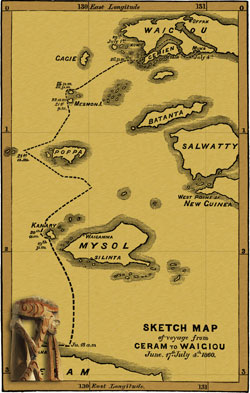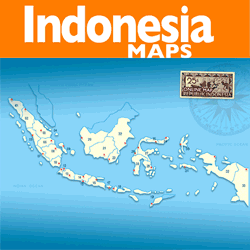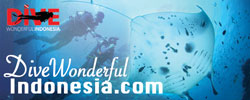Welcome to Raja Ampat
CHAPTER XXXV :
VOYAGE FROM CERAM TO WAIGIOU (JUNE AND JULY 1860)

About eight in the evening of June 25th we started, and found that with all hands at work we could just haul up our mainsail. We had a fair wind during the night and sailed north-east, finding ourselves in the morning about twenty miles west of the extremity of Waigiou with a number of islands intervening. About ten o'clock we ran full on to a coral reef, which alarmed us a good deal, but luckily got safe off again. About two in the afternoon we reached an extensive coral reef, and were sailing close alongside of it, when the wind suddenly dropped, and we drifted on to it before we could get in our heavy mainsail, which we were obliged to let run down and fall partly overboard. We had much difficulty in getting off, but at last got into deep water again, though with reefs and islands all around us. At night we did not know what to do, as no one on board could tell where we were or what dangers might surround us, the only one of our crew who was acquainted with the coast of Waigiou having been. left on the island. We therefore took in all sail and allowed ourselves to drift, as we were some miles from the nearest land. A light breeze, however, sprang up, and about midnight we found ourselves again bumping over a coral reef. As it was very dark, and we knew nothing of our position, we could only guess how to get off again, and had there been a little more wind we might have been knocked to pieces. However, in about half an hour we did get off, and then thought it best to anchor on the edge of the reef till morning. Soon after daylight on the 7th, finding our prau had received no damage, we sailed on with uncertain winds and squalls, threading our way among islands and reefs, and guided only by a small map, which was very incorrect and quite useless, and by a general notion of the direction we ought to take. In the afternoon we found a tolerable anchorage under a small island and stayed for the night, and I shot a large fruit-pigeon new to me, which I have since named Carpophaga tumida. I also saw and shot at the rare white-headed kingfisher (Halcyon saurophaga), but did not kill it. The next morning we sailed on, and having a fair wind reached the shores of the large island of Waigiou. On rounding a point we again ran full on to a coral reef with our mainsail up, but luckily the wind had almost died away, and with a good deal of exertion we managed get safely off.
We now had to search for the narrow channel among islands, which we knew was somewhere hereabouts, and which leads to the villages on the south side ofWaigiou. Entering a deep bay which looked promising, we got to the end of it, but it was then dusk, so we anchored for the night, and having just finished all our water could cook no rice for supper. Next morning early (29th) we went on shore among the mangroves, and a little way inland found some water, which relieved our anxiety considerably, and left us free to go along the coast in search of the opening, or of some one who could direct us to it. During the three days we had now been among the reefs and islands, we had only seen a single small canoe, which had approached pretty near to us, and then, notwithstanding our signals, went off in another direction. The shores seemed all desert; not a house, or boat, or human being, or a puff of smoke was to be seen; and as we could only go on the course that the ever-changing wind would allow us (our hands being too few to row any distance), our prospects of getting to our destination seemed rather remote and precarious. Having gone to the eastward extremity of the deep bay we had entered, without finding any sign of an opening, we turned westward; and towards evening were so fortunate as to find a small village of seven miserable houses built on piles in the water. Luckily the Orang- kaya, or head man, could speak a little. Malay, and informed us that the entrance to the strait was really in the bay we had examined, but that it was not to be seen except when- close inshore. He said the strait was often very narrow, and wound among lakes and rocks and islands, and that it would take two days to reach the large village of Muka, and three more to get to Waigiou. I succeeded in hiring two men to go with us to Muka, bringing a small boat in which to return; but we had to wait a day for our guides, so I took my gun and made a little excursion info the forest. The day was wet and drizzly, and I only succeeded in shooting two small birds, but I saw the great black cockatoo, and had a glimpse of one or two Birds of Paradise, whose loud screams we had heard on first approaching the coast.
Leaving the village the next morning (July 1st) with a light wind, it took us all day to reach the entrance to the channel, which resembled a small river, and was concealed by a projecting point, so that it was no wonder we did not discover it amid the dense forest vegetation which everywhere covers these islands to the water's edge. A little way inside it becomes bounded by precipitous rocks, after winding among which for about two miles, we emerged into what seemed a lake, but which was in fact a deep gulf having a narrow entrance on the south coast. This gulf was studded along its shores with numbers of rocky islets, mostly mushroom shaped, from the `eater having worn away the lower part of the soluble coralline limestone, leaving them overhanging from ten to twenty feet. Every islet was covered will strange-looping shrubs and trees, and was generally crowned by lofty and elegant palms, which also studded the ridges of the mountainous shores, forming one of the most singular and picturesque landscapes I have ever seen. The current which had brought us through the narrow strait now ceased, and we were obliged to row, which with our short and heavy prau was slow work. I went on shore several times, but the rocks were so precipitous, sharp, and honeycombed, that Ifound it impossible to get through the tangled thicket with which they were everywhere clothed. It took us three days to get to the entrance of the gulf, and then the wind was such as to prevent our going any further, and we might have had to wait for days or weeps, when, much to my surprise and gratification, a boat arrived from Muka with one of the head men, who had in some mysterious manner heard I was on my way, and had come to my assistance, bringing a present of cocoa-nuts and vegetables. Being thoroughly acquainted with the coast, and having several extra men to assist us, he managed to get the prau along by rowing, poling, or sailing, and by night had brought us safely into harbour, a great relief after our tedious and unhappy voyage. We had been already eight days among the reefs and islands of Waigiou, coming a distance of about fifty miles, and it was just forty days since we had sailed from Goram.
Immediately on our arrival at Muka, I engaged a small boat and three natives to go in search of my lost men, and sent one of my own men with them to make sure of their going to the right island. In ten days they returned, but to my great regret and disappointment, without the men. The weather had been very bad, and though they had reached an island within sight of that in which the men were, they could get no further. They had waited there six days for better weather, and then, having no more provisions, and the man I had sent with them being very ill and not expected to live, they returned. As they now knew the island, I was determined they should make another trial, and (by a liberal payment of knives, handkerchiefs, and tobacco, with plenty of provisions) persuaded them to start back immediately, and make another attempt. They did not return again till the 29th of July, having stayed a few days at their own village of Bessir on the way; but this time they had succeeded and brought with them my two lost men, in tolerable health, though thin and weak. They had lived exactly a month on the island had found water, and had subsisted on the roots and tender flower-stalks of a species of Bromelia, on shell-fish. and on a few turtles' eggs. Having swum to the island, they had only a pair of trousers and a shirt between them, but had made a hut of palm-leaves, and had altogether got on very well. They saw that I waited for them three days at the opposite island, but had been afraid to cross, lest the current should have carried them out to sea, when they would have been inevitably lost. They had felt sure I would send for them on the first opportunity, and appeared more grateful than natives usually are for my having done so; while I felt much relieved that my voyage, though sufficiently unfortunate, had not involved loss of life.

Learn to Cook Papeda at Weriagar District, West Papua
Weriagar is a district located in Teluk Bintuni Regency, West Papua Province, Indonesia. The staple food of the local Weriagar community is Papeda. Papeda is made from sago cooked in boiling water on a stove until the dough looks like glue. Papeda is delicious eaten with fish in soup. Sayur bunga pepaya (papaya flower bud vegetables) and tumis kangkung (stir-fried water spinach) are often served as side-dish vegetables to accompany papeda. On some coasts and lowlands on Papua, sago is the main ingredient to all the foods. Sagu bakar, sagu…
Tanjung Kasuari, Sorong
Tanjung Kasuari beach is located in Sorong city, West Papua. This tourism object is becomes one of the most visited tourism objects in Sorong and it has been visited almost everyday. It located around 7Km from down town of Sorong city, and it can be reach by using private vehicle or public transportation. The nuance in this beach is windy and it has white sandy path along the beach, the clear water and coconut trees along the area. It so refreshing and tropical alike. Moreover, the visitors can enjoy the sunset…
Nusrowi Island, The Exotic One On West Papua
Nusrowi Island is located on the west of Rumberpon island, Wondama Bay district. This small island has an area of ??approximately 4 hectares and surrounded by shallow waters and filled with coral reefs and many species of ornamental fish. You can also see other marine commodities like grouper, sea cucumbers and lobsters. In this place you can do your favorite activities such as diving, coral reef observations and fishing; to get to this place from Ransiki to a location, we can use a longboat which takes about 1.5 hours. www.Indonesia-Tourism.com
Amazingly Fak Fak
Fak Fak This district is famous for the agriculture plant of nutmeg, which make this city known as “Kota Pala” or the city of nutmeg. Fakfak regency is one of the oldest cities in Papua, with a high civilization. Historically Fakfak was a significant port town, being one of the few Papuan towns that had relations with the Sultanate of Ternate, being bound to it. The Sultanate later granted the Dutch colonial government permission to settle in Papua, including in Fakfak. The Dutch began the settlement in 1898. The town…









